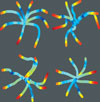

Cambridge Consultants is providing key technology behind a novel brain-computer interface (BCI) device system that translates brain waves into computer control commands – without the need for electrodes implanted in the brain.
The BCI system is being developed by the Wadsworth Center, a public health laboratory for the New York State Department of Health, to help even individuals who are completely paralysed, to communicate with the outside world.
According to the Wadsworth Center's BCI group, the system has been proven to match the capabilities of costly invasive systems that require surgery to implant electrodes in the brain - and should be able to help individuals who have lost all muscular control. This is something other augmentative or assistive communications approaches such as eyeball-tracking systems cannot.
The BCI system consists of three primary hardware components and several pieces of specialised software. A mesh cap holds small sensor electrodes firmly against the user's head. An amplifier is connected to the electrodes and is used to boost the minute analog signals (measured in microvolts) received from the surface of the scalp (electroencephalographic activity) into a more robust signal, which is then converted into a digital signal and analysed by specially-designed signal processing software running on a PC. Two monitors are connected to the PC, one for the caregiver interface and one for the user interface.
One of the hurdles included developing a sensor cap that was comfortable enough for extended wear yet allowed an untrained caregiver to position the sensors accurately on the head. Positioning deviations from session to session of more than a few millimeters can dramatically affect the accuracy of the system.
Cambridge Consultants is pursuing several alternative sensor cap designs to make them more ergonomically comfortable and be less obtrusive, without sacrificing repeatability and precision of sensor placement and signal reception. The firm provided electronics hardware and software device drivers to link the BCI software with the hardware from several different manufacturers. It also helped create a graphical software interface with icons and sound so that patients can more readily communicate with their caregivers. For example, patients can now access icons for 'water' and 'food,' and traverse a menu with a variety of choices using their brain waves.
Patients make these selections in either of two ways. In one, they pay attention to a particular icon displayed among many in a grid on the computer screen. As the various icons flash in succession, a distinct electrical response is evoked in the brain by the attended icon. The system tracks the timing of the flashes and the evoked response, identifies the attended icon and outputs the appropriate control signal.
In the second method, the user can imagine particular movements. Even if the user is totally paralysed, this imagined action generates a localised electrical stimulus in the brain that can be detected by the BCI system. It then maps that action to moving the computer cursor in a particular direction, allowing the user to navigate menu structures to select actions and/or perform word processing activities. The BCI system can also be used by people speaking any language, since the system is icon-driven versus text-driven.
Powered by a standard laptop computer, the research groups are confident that they can develop a $5000 solution that works better than one that could quite easily cost tens of thousands of dollars.
Shown are the traces recorded from the scalps of four individuals using the BCI system to move a cursor from the centre of a computer screen to targets around the edge. The cursor paths are shown, with colour representing speed at each point, from slowest (blue) to fastest (red).
Brain-computer interfaces
Brain-computer interfaces (BCIs) can provide communication and control to people who are totally paralysed. BCIs can use noninvasive or invasive methods for reading brain signals that convey a user's commands. Non-invasive BCIs using scalp-recorded electroencephalographic activity and adaptive algorithms can provide people, including people with spinal cord injuries, multidimensional point-to-point control of a computer cursor that falls within the range of that reported with invasive methods. BCIs could eventually become an important communication and control option for people with severe motor disabilities who could use brain signals to operate a robotic arm or a neuroprosthesis without needing to have electrodes implanted in their brains.

© Technews Publishing (Pty) Ltd | All Rights Reserved